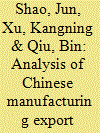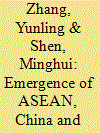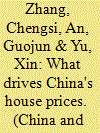|
|
|
Sort Order |
|
|
|
Items / Page
|
|
|
|
|
|
|
| Srl | Item |
| 1 |
ID:
113693


|
|
|
|
|
| Publication |
2012.
|
| Summary/Abstract |
This paper studies the duration of Chinese manufacturing exports and its determinants, using disaggregated 6-digit level Harmonized System product trade data from 1995 to 2007. Cox proportional hazard, Weibull and exponential models are used to examine the effects of various factors on export duration. It is revealed that export duration tends to be rather short-lived. It is also found that GDP and GDP per capita of the export destination have positive effects on export duration, while trade relationships with distant and landlocked countries are generally of shorter duration. In addition, export duration is longer for differentiated and parts and components products, as well as products with large initial trade values. WTO membership is also important for longer export duration. Our empirical analysis suggests that developed markets, such as the USA and the EU, are important to China, and should still be the major sources for Chinese export growth in the long run. Moreover, technical innovation of firms and free trade agreement negotiations will be helpful for sustainable export growth.
|
|
|
|
|
|
|
|
|
|
|
|
|
|
|
|
| 2 |
ID:
113696


|
|
|
|
|
| Publication |
2012.
|
| Summary/Abstract |
The role of China in East Asia's recovery from the recent global financial and economic crisis highlights China's position as an engine of growth for this region. From the viewpoint of China, there are many potential gains from entering into free trade agreements (FTAs) with its neighbors, who collectively form a large and fast-growing market. In this paper, we qualitatively and quantitatively assess the four main permutations of China's FTAs with East Asian major economies: China-ASEAN, China-Japan, China-Korea and ASEAN+3. We compare the effects of these FTAs on China's output and welfare. Our comparative analysis shows that China will gain from all three bilateral FTAs, while gaining the most from the ASEAN+3. Because forming a region-wide FTA, such as the ASEAN+3, is expected to be gradual and difficult, China should continue to engage in bilateral FTAs as a medium-term and alternative strategy. However, in the long term, China should pursue a region-wide FTA.
|
|
|
|
|
|
|
|
|
|
|
|
|
|
|
|
| 3 |
ID:
113692


|
|
|
|
|
| Publication |
2012.
|
| Summary/Abstract |
In this paper, we emphasize the interactive effect between life expectancy and human capital accumulation, and test the positive feedback of longevity to educational investment in China. This is very important for understanding the pressure from the aging population and the increase in private educational investment in China. We first show in an extended human capital investment model that life expectancy growth acts as a driving force for educational investment. We then build a difference-in-difference-in-differences empirical framework and use cross-province data to examine the effect in China. We use the maternal mortality rate (MMR) to identify the difference in life expectancy between genders, and the illiteracy rate or average years of education by gender for educational investment. The empirical results comply with the theory, in that increases in life expectancy significantly lower illiteracy rates and improve the average schooling years in China. This content of the present paper is closely related to crucial issues like population aging, human capital accumulation and gender discrimination. Policy implications are discussed based on the empirical results.
|
|
|
|
|
|
|
|
|
|
|
|
|
|
|
|
| 4 |
ID:
113695


|
|
|
|
|
| Publication |
2012.
|
| Summary/Abstract |
The rise of ASEAN, China and India as economic powers is of great significance to regional as well as global economic development. Although their ascendance in the global economy will continue, they will have to go to great pains to meet the new challenges. Considering ASEAN, China and India as a group, due to their differences in economic development levels, economic structures and policy concern priorities, it is difficult for them to formulate a unified position on a range of global issues. ASEAN, China and India must foster an open, transparent and efficient regional as well as global environment. They need to cooperate in designing the architecture to ensure regional as well as global freer trade and investment and more stable finance, and to play more active roles in future global governance and rulemaking.
|
|
|
|
|
|
|
|
|
|
|
|
|
|
|
|
| 5 |
ID:
113694


|
|
|
|
|
| Publication |
2012.
|
| Summary/Abstract |
Many published studies have considered information asymmetry between domestic and foreign investors about local assets in the stock market, particularly in developed markets. The present study proposes a new perspective to address the issue in the case of China's forward exchange rate market. Following the framework of Clarida and Taylor (1997), the term structures of exchange rates in the domestic forward and the non-deliverable forward markets are constructed and then applied to predict future spot exchange rates based on a vector equilibrium correction model. By comparing the forecast accuracy on the basis of the root mean square error and the mean absolute error, it is shown that dynamic out-of-sample forecasts of the domestic forward market are superior to those of the non-deliverable forward market, suggesting that domestic investors are better informed than foreign investors. The result has several important policy implications, especially for exchange rate determination.
|
|
|
|
|
|
|
|
|
|
|
|
|
|
|
|
| 6 |
ID:
113690


|
|
|
|
|
| Publication |
2012.
|
| Summary/Abstract |
To explain China's dramatic economic growth, researchers have proposed a "tournament thesis." According to this thesis, the central government's ability to set growth targets has played a crucial role in growth since political promotion is largely based on local economic growth. We use provincial officials' career mobility data to test this thesis. For both time periods (1979-1995 and 1979-2002), economic performance, measured in annual, average and relative terms, did not affect these officials' career advancement. We then sketch an alternative analytical framework to explain Chinese local officials' strong urge for developmentalism and, finally, draw policy implications from this explanatory framework.
|
|
|
|
|
|
|
|
|
|
|
|
|
|
|
|
| 7 |
ID:
113691


|
|
|
|
|
| Publication |
2012.
|
| Summary/Abstract |
The high and rising house prices in China are not adequately accounted for the traditional explanations emphasizing demand-driven or cost-push factors. Recent published studies claim that gender imbalance increases competition among men in the marriage market, which has pushed Chinese, especially parents with a son, to buy houses as a signal of relative status in the marriage market; this marriage competition then causes high demand for houses and eventually leads to rising house prices in China. Empirical results in this paper, however, provide little support for this hypothesis and we find that a rise in the sex ratios for most age cohorts accounts for very small percentage variations in house price movements in China during 1998-2009. Further investigation suggests that excess demand driven by high monetary growth was a significant cause of the rising house prices in China during 1998-2009. Therefore, the impact of gender imbalance on house prices should not be exaggerated and monetary dynamics remains an important leading indicator for house price movements in China.
|
|
|
|
|
|
|
|
|
|
|
|
|
|
|
|
|
|
|
|
|